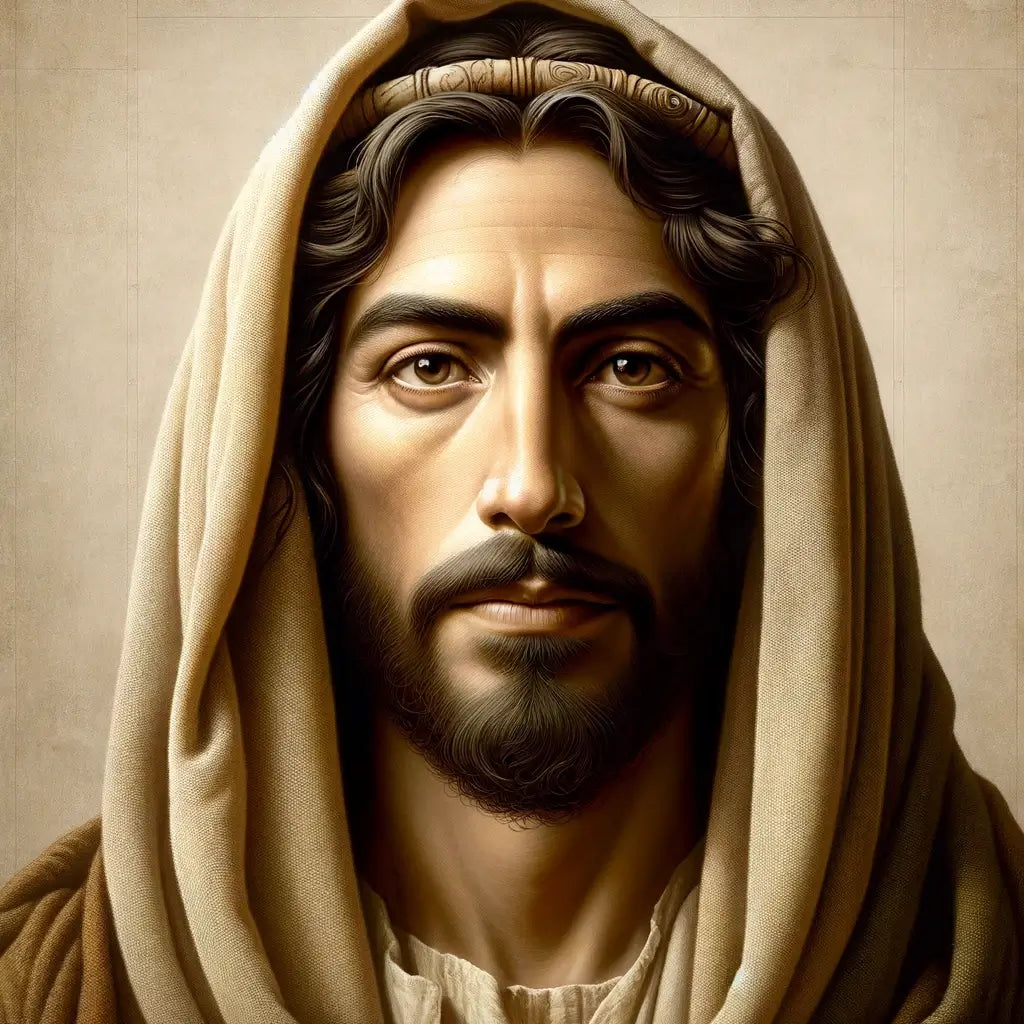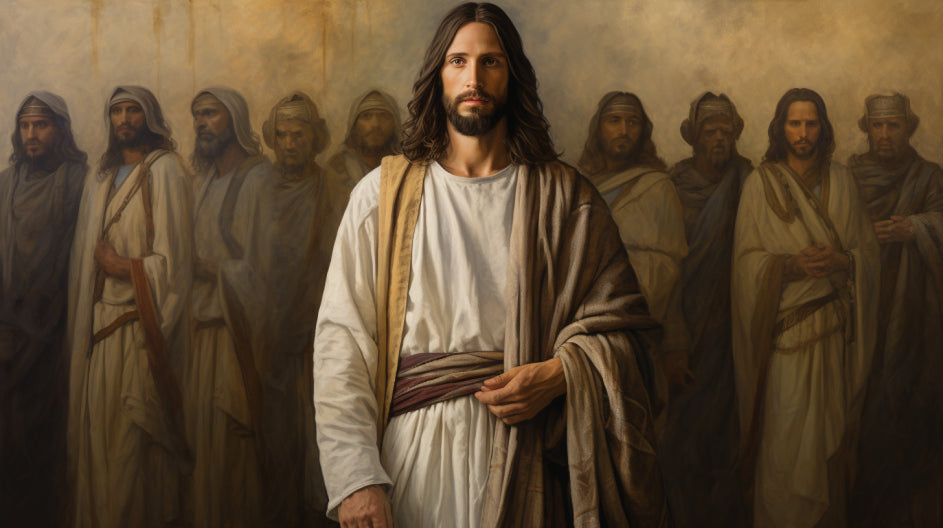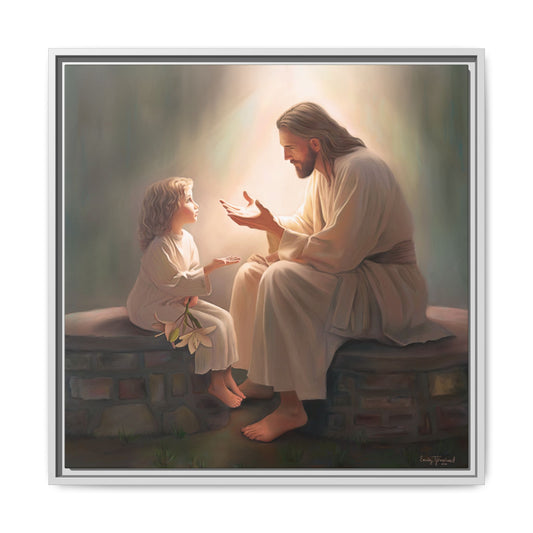
White Jesus Paintings
Share
Imagine if we could color correct history as easily as a photo? That's essentially what's happened with 'White Jesus' paintings. We've seen them in countless churches, textbooks, and homes. Yet these widely accepted images of Christ, characterized by European features, are more a testament to cultural bias than historical accuracy. In our exploration, we're not just debunking myths. We're peeling back layers of societal norms, daring to question the intersection of religion, race, and art. We're also championing diverse representations, because innovation isn't just about creating new things, but seeing old things in new ways.
Galatians 3:28: 'There is neither Jew nor Greek, there is neither slave nor free, there is no male and female, for you are all one in Christ Jesus.' This verse underscores the universality of Jesus's message, emphasizing that in the eyes of God, the social distinctions and ethnic differences that divide humanity are irrelevant. Revelation 7:9: 'After this I looked, and behold, a great multitude that no one could number, from every nation, from all tribes and peoples and languages, standing before the throne and before the Lamb, clothed in white robes, with palm branches in their hands.' This vision from Revelation highlights the diversity of Jesus's followers and the inclusive nature of salvation, representing a multitude from every ethnicity and culture united in worship. Matthew 28:19: 'Go therefore and make disciples of all nations, baptizing them in the name of the Father and of the Son and of the Holy Spirit.' Jesus's commission to His disciples emphasizes the global scope of His mission, reflecting a call to reach all peoples across ethnic and cultural boundaries. 2 Nephi 26:33 (Book of Mormon): 'For none of these iniquities come of the Lord; for he doeth that which is good among the children of men; and he doeth nothing save it be plain unto the children of men; and he inviteth them all to come unto him and partake of his goodness; and he denieth none that come unto him, black and white, bond and free, male and female; and he remembereth the heathen; and all are alike unto God, both Jew and Gentile.' This scripture emphasizes God's impartiality and the universal invitation to come unto Christ, highlighting the equality of all people before God. Doctrine and Covenants 18:10-11: 'Remember the worth of souls is great in the sight of God; For, behold, the Lord your Redeemer suffered death in the flesh; wherefore he suffered the pain of all men, that all men might repent and come unto him.' This passage speaks to the value of every individual to God and the universal application of Jesus's atonement, reinforcing the idea that Jesus's sacrifice was for all humanity, irrespective of their physical appearance or origin. Moses 5:8 (Pearl of Great Price): 'And the Lord God called upon men by the Holy Ghost everywhere and commanded them that they should repent; And as many as believed in the Son, and repented of their sins, should be saved; and as many as believed not and repented not, should be damned; and the words of God were verified, which he spake unto Adam, saying: Inasmuch as ye were born into the world by water, and blood, and the spirit, which I have made, and so become of dust a living soul.' This emphasizes the call to all of humanity to come unto Christ, underscoring the inclusivity of His message and the salvation He offers. In discussing "White Jesus," it's crucial to focus on the universal aspects of Jesus's identity and mission, recognizing that He transcends any one culture or ethnicity. This approach allows for a more inclusive understanding of Jesus that can embrace and celebrate the rich diversity of His followers around the world.




 A comprehensive examination of historical sources and accounts yields no definitive depiction of Jesus as a white man. This lack of evidence poses a significant challenge to historians and scholars who strive for accuracy in their representations. The Bible is notably silent on Jesus' physical appearance, with no explicit reference to his skin color, hair texture, or eye color. The New Testament, for instance, doesn't provide any specific details about Jesus' physical characteristics. The Old Testament prophesies in Isaiah 53:2-3 describe Jesus in abstract terms, not revealing any concrete information about his physical attributes.
A comprehensive examination of historical sources and accounts yields no definitive depiction of Jesus as a white man. This lack of evidence poses a significant challenge to historians and scholars who strive for accuracy in their representations. The Bible is notably silent on Jesus' physical appearance, with no explicit reference to his skin color, hair texture, or eye color. The New Testament, for instance, doesn't provide any specific details about Jesus' physical characteristics. The Old Testament prophesies in Isaiah 53:2-3 describe Jesus in abstract terms, not revealing any concrete information about his physical attributes.










 Our journey has enlightened us on the historical, cultural, and sociopolitical factors that have shaped the dominant portrayals of Jesus. It's our collective responsibility to appreciate diversity and foster a inclusive understanding of the beauty of Jesus Christ and the spirit of unity that he taught.
Our journey has enlightened us on the historical, cultural, and sociopolitical factors that have shaped the dominant portrayals of Jesus. It's our collective responsibility to appreciate diversity and foster a inclusive understanding of the beauty of Jesus Christ and the spirit of unity that he taught.

Key Takeaways
- The Bible provides little information about Jesus' appearance, leading to a lack of concrete descriptions.
- Early depictions of Jesus varied, with some showing him as a Roman or Greek figure and others as the Good Shepherd without a beard.
- White Jesus became popular in Europe as Christianity gained prominence, leading to the spread of white Jesus depictions throughout history.
- There is a growing openness to new depictions of Jesus as a person of color, challenging the long-standing portrayal of Jesus as white.
White Jesus Paintings
Turning our attention to 'White Jesus Paintings', it's essential to acknowledge the profound significance these images hold in religious and cultural discourse. These portrayals, born out of a certain historical and cultural context, have shaped and continue to influence perceptions of the divine figure in the mind of those who's culture where they are viewed. To fully comprehend the implications, we are invited to evaluate these depictions, consider their origins, and understand their impact on diverse societies.Brief Overview of White Jesus portraits
A discussion around a "white Jesus" involves navigating complex cultural, historical, and theological discussions. The portrayal of Jesus as white has been a topic of debate, reflecting broader conversations about representation, ethnicity, and the contextualization of religious figures within various cultures. In discussing this subject, it's important to approach it with sensitivity, acknowledging that artistic representations of Jesus have varied widely across time and cultures, often reflecting the ethnicity and cultural norms of the society producing the art rather than historical accuracy. The scriptures do not provide a detailed physical description of Jesus, allowing for a wide range of interpretations in artistic and cultural expressions. However, we can explore scriptural references that emphasize the universality of Jesus's message and His role as the Savior for all humanity, highlighting the spiritual rather than the physical depiction.Galatians 3:28: 'There is neither Jew nor Greek, there is neither slave nor free, there is no male and female, for you are all one in Christ Jesus.' This verse underscores the universality of Jesus's message, emphasizing that in the eyes of God, the social distinctions and ethnic differences that divide humanity are irrelevant. Revelation 7:9: 'After this I looked, and behold, a great multitude that no one could number, from every nation, from all tribes and peoples and languages, standing before the throne and before the Lamb, clothed in white robes, with palm branches in their hands.' This vision from Revelation highlights the diversity of Jesus's followers and the inclusive nature of salvation, representing a multitude from every ethnicity and culture united in worship. Matthew 28:19: 'Go therefore and make disciples of all nations, baptizing them in the name of the Father and of the Son and of the Holy Spirit.' Jesus's commission to His disciples emphasizes the global scope of His mission, reflecting a call to reach all peoples across ethnic and cultural boundaries. 2 Nephi 26:33 (Book of Mormon): 'For none of these iniquities come of the Lord; for he doeth that which is good among the children of men; and he doeth nothing save it be plain unto the children of men; and he inviteth them all to come unto him and partake of his goodness; and he denieth none that come unto him, black and white, bond and free, male and female; and he remembereth the heathen; and all are alike unto God, both Jew and Gentile.' This scripture emphasizes God's impartiality and the universal invitation to come unto Christ, highlighting the equality of all people before God. Doctrine and Covenants 18:10-11: 'Remember the worth of souls is great in the sight of God; For, behold, the Lord your Redeemer suffered death in the flesh; wherefore he suffered the pain of all men, that all men might repent and come unto him.' This passage speaks to the value of every individual to God and the universal application of Jesus's atonement, reinforcing the idea that Jesus's sacrifice was for all humanity, irrespective of their physical appearance or origin. Moses 5:8 (Pearl of Great Price): 'And the Lord God called upon men by the Holy Ghost everywhere and commanded them that they should repent; And as many as believed in the Son, and repented of their sins, should be saved; and as many as believed not and repented not, should be damned; and the words of God were verified, which he spake unto Adam, saying: Inasmuch as ye were born into the world by water, and blood, and the spirit, which I have made, and so become of dust a living soul.' This emphasizes the call to all of humanity to come unto Christ, underscoring the inclusivity of His message and the salvation He offers. In discussing "White Jesus," it's crucial to focus on the universal aspects of Jesus's identity and mission, recognizing that He transcends any one culture or ethnicity. This approach allows for a more inclusive understanding of Jesus that can embrace and celebrate the rich diversity of His followers around the world.
White Jesus
In our exploration of the topic, we'll first examine the prevalence of white Jesus portraits, a phenomenon rooted in historical, cultural, and theological contexts. These portraits emerged prominently during the spread of Christianity throughout Europe, where Jesus began to be depicted with European features. This portrayal of a white Jesus, we find, served dual purposes. It not only reinforced the dominant culture's image of divinity but also subtly may have hinted at their perceived cultural superiority. Over time, this image of a white Jesus has become entrenched in popular culture and religious iconography. However, it's helpful to note that such representations are more reflective of the artists' cultural contexts than historical accuracy.Historical and Cultural Context of Jesus' Portrayal
Countless depictions of Jesus as a white man, often seen in paintings, are significantly influenced by the historical and cultural context in which they were created. Here's why this concept is worth visiting:- It helps us separate artistic interpretation from historical accuracy. Jesus was a Middle Eastern Jew, and his portrayal as a white man reflects more about the society creating the image than Jesus himself.
- It highlights how these images were sometimes perceived to reinforce power structures, perhaps promoting the idea that whiteness is divinely preferred.
- It encourages us to challenge traditional portrayals and embrace a more diverse representation of religious figures, fostering inclusivity and understanding.
Historical Context and Origins of Jesus Portraits
In examining the historical context and origins of Jesus portraits, we must first acknowledge the early depictions of Jesus in Christian art. These images, noticeably influenced by cultural context and artists' interpretations, laid the foundation for Eurocentric representations that emerged as Christianity gained prominence. Critically, these European portrayals not only shifted Jesus' depiction but also significantly impacted religious and societal perceptions in the centuries that followed.Early depictions of Jesus in Christian art
The influence of Roman traditions, coupled with Greek and Eastern representations, played a significant role in shaping these early depictions. In examining these images, we'll uncover the profound impact of cultural and societal norms on the portrayal of religious figures such as Jesus.
Influence of the Roman traditions
- Byzantine artists often portrayed Jesus as an authoritative, supernatural figure, reflecting their empire's political structures.
- Roman influences brought a more humanized Jesus, depicting him as the 'Good Shepherd'.
- These differing approaches fused, shaping the development of Christian iconography and the widespread image of a white Jesus.
Greek and Eastern representations of Jesus
We're now turning our focus to the Greek and Eastern representations of Jesus, exploring the historical context and origins of these portraits in early Christian art. These depictions, while significant, differ greatly from the conventional White Jesus paintings. The Greek and Eastern images were reflective of their cultural context, often portraying Jesus with features typical to their region. Let's now segue into the emergence of European portrayals, to explore how these White Jesus paintings evolved.Emergence of European portrayals
As we turn our focus to the emergence of European portrayals of Jesus, it's essential to consider the historical context that influenced these depictions. The Renaissance period, for instance, played a significant role, as artists began to personalize religious figures, often reflecting their own societal norms and biases. Furthermore, the impact of European dominance and colonization can't be underestimated in the widespread acceptance and propagation of these images.
Depictions during the Renaissance period
During the Renaissance, many of the iconic images of a white Jesus we may be familiar with today began to take shape. These depictions during the Renaissance period were largely influenced by:- The prevalent Eurocentric views of the time.
- The Renaissance artists' interpretation of biblical descriptions.
- The Church's endorsement of these white Jesus paintings.
Impact of European dominance and colonization
Understanding the impact of European dominance and colonization, we now visit how these historical factors influenced the emergence of European portrayals of Jesus. The European Jesus became a symbol of superiority, reinforcing the colonizers' dominance. This image was used to enforce caste systems, suppress indigenous cultures, and ultimately, shape much of the global Christian narrative.

Eurocentrism and dominant cultural influence
The influence of Eurocentrism and the dominant cultural influence on the depiction of Jesus as white, a phenomenon often referred to as the 'White Jesus Phenomenon'. This is driven by:- Eurocentric dominance in art history.
- Cultural assimilation through religious imagery.
- Colonialism's impact on global religious perception.

Historical evidence suggesting Jesus was not white
We'll now turn our attention to historical evidence that challenges the notion of a white Jesus. Considering the geographic and historical context of Jesus' life, it's helpful to reflect upon the ethnic and cultural diversity present in the region during his time.Geographic and historical context of Jesus' life
Historical and geographic evidence strongly suggests Jesus wasn't the fair-skinned figure often portrayed in Western art and culture. In the geographic and historical context of Jesus' life,- He lived in a region with predominantly dark-skinned inhabitants.
- Biblical texts offer no clear description of his physical appearance.
- Early depictions varied widely.
 A comprehensive examination of historical sources and accounts yields no definitive depiction of Jesus as a white man. This lack of evidence poses a significant challenge to historians and scholars who strive for accuracy in their representations. The Bible is notably silent on Jesus' physical appearance, with no explicit reference to his skin color, hair texture, or eye color. The New Testament, for instance, doesn't provide any specific details about Jesus' physical characteristics. The Old Testament prophesies in Isaiah 53:2-3 describe Jesus in abstract terms, not revealing any concrete information about his physical attributes.
A comprehensive examination of historical sources and accounts yields no definitive depiction of Jesus as a white man. This lack of evidence poses a significant challenge to historians and scholars who strive for accuracy in their representations. The Bible is notably silent on Jesus' physical appearance, with no explicit reference to his skin color, hair texture, or eye color. The New Testament, for instance, doesn't provide any specific details about Jesus' physical characteristics. The Old Testament prophesies in Isaiah 53:2-3 describe Jesus in abstract terms, not revealing any concrete information about his physical attributes.
Examination of historical sources and accounts
Digging into historical sources and accounts, we're finding a lack of solid evidence to support the depiction of Jesus as a white man. Early historical sources, including the Bible itself, don't provide clear descriptions of Jesus's physical attributes. While white Jesus paintings have become prevalent, they're relatively recent developments, influenced heavily by European culture and colonialism. It's essential to remember that Jesus was a Jew from the Middle East, and his appearance would have reflected that reality. The white Jesus that dominates Western imagination is more a product of historical cultural contexts than factual evidence. It's fascinating to see how artists challenge these inaccurate representations and promote a more historically accurate, inclusive depiction of Jesus. The challenges faced by historians and scholars in relation to white Jesus paintings are multi-faceted:- Lack of Historical Accuracy: The Bible doesn't provide a detailed physical description of Jesus, leaving his depictions open to interpretation and cultural bias.
- Cultural Dominance: The prevalence of a white Jesus in historical art and media has ingrained this image into the collective consciousness, making it difficult to challenge.
- Misinterpretation and Misuse: The white Jesus image has often been used to justify racial hierarchies and colonial endeavors, further complicating its deconstruction.

Importance of Diverse Jesus Portraits
The overarching dominance of white Jesus paintings may limit our understanding of the historical Jesus and possibly inhibit religious inclusivity. By promoting diverse portrayals of Jesus, we can foster dialogue and understanding among different cultures, enabling a more inclusive representation of Christianity. This shift in representation can challenge and reshape our tightly-held concepts, thereby broadening our collective understanding of Jesus's identity. In our journey through the topic of 'White Jesus Paintings', we've arrived at a critical juncture - the importance of diverse Jesus portraits. This shift towards inclusivity not only reflects the heterogeneous nature of believers worldwide but also underscores the universality and compassion of Jesus.
Reflecting the diversity of believers worldwide
While we understand that the historical Jesus likely didn't resemble the popular white depictions, it may be helpful to promote diverse representations of Jesus to reflect the global diversity of believers. This involves:- Reevaluating 'white Jesus paintings' for their Eurocentric bias.
- Encouraging artists to create inclusive portraits.
- Educating the public about the importance of reflecting the diversity of believers worldwide in religious imagery.
Emphasizing Jesus' universality and compassion
As we showcase diverse representations of Jesus, one must remember that his message of love, compassion, and universality transcends any physical depiction. By emphasizing Jesus' universality and compassion, rather than adhering strictly to the white Jesus paradigm, we foster inclusivity and respect for diverse beliefs and cultures.
Encouraging dialogue and understanding among different cultures
We must acknowledge the far-reaching influence of Christianity, which extends beyond any specific culture or geographic boundary. In light of this, it's helpful to appreciate the diverse perspectives of all believers, understanding that the image of Jesus may vary across different cultures. This opens the door for rich, multi-faceted discussions that enhance our collective understanding and foster mutual respect. Recognizing the global impact of Christianity, it's crucial for us to understand the importance of diverse portrayals of Jesus, which can encourage dialogue and understanding among different cultures.- White Jesus paintings have permeated global religious art.
- Diverse representations challenge these norms, promoting multicultural engagement.
- This fosters an inclusive Christianity, respecting all cultural perspectives.
Appreciating the perspectives of all believers
Numerous believers around the world are beginning to appreciate the importance of diverse depictions of Jesus, encouraging dialogue and fostering understanding among different cultures. More than just challenging the dominance of white Jesus paintings, it's about appreciating the perspectives of all believers. This openness to diversity sparks conversations, bridging cultural gaps, and allowing a richer understanding of Jesus' universal message.
Worshipful Expressions of Jesus Portraits
We must consider the profound influence of art on worship and devotion, particularly in the context of Jesus's portrayal. These depictions, often white, have shaped the collective consciousness and devotion of believers for centuries. To challenge this, we advocate for encouraging artists to explore and depict Jesus in a myriad of ways, reflecting the diversity of the global Christian community.The power of art in worship and devotion
We acknowledge the profound impact that artistic portrayals of Jesus, have had on worship and devotion. These images, steeped in historical significance, have shaped religious perspectives and inspired faith across centuries. Through such visuals, believers find a tangible, albeit culturally influenced, expression of divinity, which often kindles a deep sense of reverence.
Historical significance of religious art
Often, we've seen how powerful religious art, particularly worshipful expressions of Jesus portraits, can be in enhancing devotion and worship. Jesus paintings, notably, have a profound historical significance in religious art. They've been known to influence theological perspectives, drive cultural interpretations of religious narratives, and shape societal attitudes towards religious diversity. Such art continues to stimulate insightful discourse around the representation of divinity.Inspiring faith and reverence through visuals
It can be fascinating to see how worshipful expressions of Jesus portraits have inspired faith and reverence throughout the ages. These visuals have transcended cultural barriers, creating a universally recognized symbol that fosters unity, aids in spiritual contemplation, and fuels our constant pursuit of innovative, inclusive expressions of the divine.





Collaborating for inclusive religious education
In light of the historical inaccuracies in traditional depictions of Jesus, it may be helpful for us to collaborate with religious institutions and leaders for a more inclusive religious education. Our journey has enlightened us on the historical, cultural, and sociopolitical factors that have shaped the dominant portrayals of Jesus. It's our collective responsibility to appreciate diversity and foster a inclusive understanding of the beauty of Jesus Christ and the spirit of unity that he taught.
Our journey has enlightened us on the historical, cultural, and sociopolitical factors that have shaped the dominant portrayals of Jesus. It's our collective responsibility to appreciate diversity and foster a inclusive understanding of the beauty of Jesus Christ and the spirit of unity that he taught.
Encouragement to foster a holistic and inclusive understanding of Jesus' portrayal
Let's begin to foster a holistic and inclusive understanding of Jesus' portrayal, acknowledging the rich diversity of his representation across different cultures and communities. As we examine Jesus paintings, it may be of interest to underline their historical context and cultural bias. However, we shouldn't stop there. This encouragement to foster a holistic and inclusive understanding of Jesus' portrayal enriches our collective imagination and promotes a more inclusive faith community.




